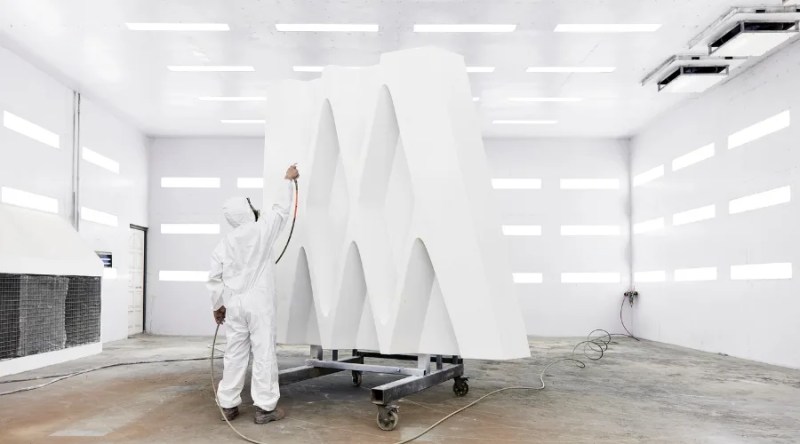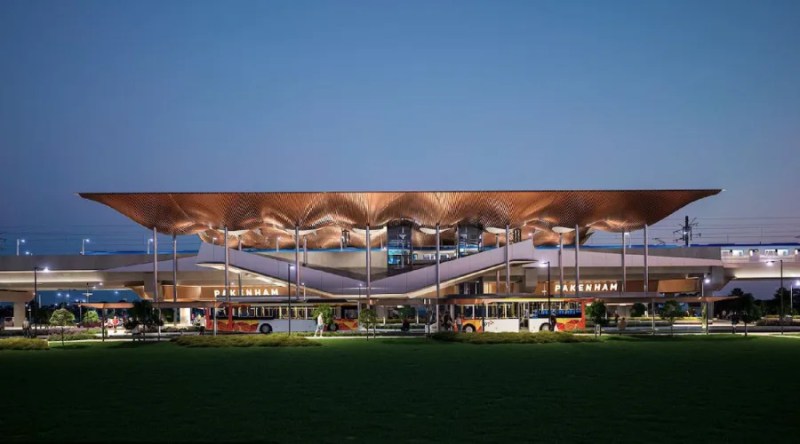The New Era of Building Design
Architecture is entering a defining moment. As global cities strive to reduce carbon footprints and meet new performance standards, the materials that shape our buildings are being re-evaluated. Traditional materials like steel, concrete, and aluminium—once the foundation of modern construction—are now being challenged by a new generation of advanced reinforced materials that combine lightness, strength, and sustainability.
This shift is not merely a technological upgrade; it’s a transformation in how architects think about form, fabrication, and the lifecycle of structures. Imagine façades that weigh a fraction of traditional cladding yet deliver five times the strength of aluminium. Imagine concrete systems that remove crystalline silica, reduce embodied carbon, and maintain high compressive strength.
These possibilities are no longer futuristic. They’re being realised today through innovations such as ShapeShell™ RT, RC, and RG—a family of advanced reinforced materials developed by ShapeShift Technologies. Designed and manufactured through precision digital processes, these materials allow architects to push the boundaries of geometry and performance while addressing environmental responsibility head-on.
From the sculptural forms of public art to the expansive façades of major transport hubs, these materials are setting new standards for architectural design and construction efficiency. The future of building design is being reinforced—literally.
What Are Advanced Reinforced Materials?
The evolution of construction materials has always mirrored the ambitions of design. In the 20th century, steel and concrete enabled skyscrapers and bridges. Today, reinforced thermosets, advanced concretes, and hybrid gypsums are enabling lightweight façades, complex geometries, and high-performance architectural envelopes that would have been impossible with conventional materials.
1. ShapeShell™ RT – Reinforced Thermoset
ShapeShell™ RT is a lightweight fibre-reinforced thermoset material, boasting up to five times the strength of aluminium while being highly customisable for complex 3D geometries. Using a vacuum-infusion manufacturing process, fibres such as glass or carbon are saturated within a resin matrix under controlled vacuum conditions. This ensures consistent material density and mechanical performance.
The result is a substrate that combines structural integrity, corrosion resistance, and design flexibility. Unlike metals that fatigue or corrode, RT panels retain performance even in harsh climates. They are commonly used for external façades, infrastructure cladding, and acoustic structures. Their mechanical profile includes tensile strengths up to 269 MPa, flexural strengths beyond 240 MPa, and outstanding resistance to UV exposure, salt spray, and moisture—making them ideal for coastal or high-sun environments.
2. ShapeShell™ RC – Reinforced Concrete
ShapeShell™ RC is a reimagined form of GRC, engineered as a lightweight glass-fibre-reinforced concrete that can be cast into any bespoke geometry using 5-axis CNC-cut moulds. The inclusion of fibre reinforcement significantly increases tensile strength, enabling thinner, lighter panels with exceptional durability.
Importantly, ShapeShift offers a Green GRC option that replaces silica sand with recycled glass, producing a silica-free and environmentally safer material. This innovation reduces embodied energy and enhances mechanical performance, achieving compressive strengths up to 45 MPa and flexural strengths exceeding 25 MPa.
The RC system can replicate traditional concrete finishes—off-form, acid-washed, or exposed aggregate—while maintaining much lower weight. Combined with an integrated railing and attachment system that allows ±20 mm site adjustability, ShapeShell™ RC simplifies façade installation and ensures consistent alignment.
3. ShapeShell™ RG – Reinforced Gypsum
For interior projects, ShapeShell™ RG offers a 30 % weight reduction compared to traditional GFRC while maintaining high flexural and compressive strength. The system combines modern fibres with a gypsum matrix and performance polymers, producing a durable, non-combustible, and easily installed solution for columns, vaults, ceiling panels, and decorative cladding.
RG panels are moulded using ASTM-compliant processes and can achieve fine surface detail without additional finishing. Their ability to balance fire safety (Class 1 under BS 476), acoustic control, and rapid installation makes them ideal for public interiors such as universities, galleries, or transport hubs.
Precision in Manufacturing
At the heart of these materials lies ShapeShift’s vertically integrated approach. Every project moves from digital design to fabrication within the same workflow, ensuring accuracy and efficiency. Two of the largest 5-axis CNC machines in the Southern Hemisphere produce precision moulds for even the most intricate geometries.
By adopting aerospace-grade manufacturing techniques, the company guarantees consistent mechanical performance and tolerance control. This digital-to-physical connection eliminates many of the uncertainties that plague conventional casting or cladding methods—reducing waste, rework, and installation time.
Why Architects Are Turning to Advanced Materials
Advanced reinforced materials do more than meet engineering requirements—they empower architectural imagination. Architects and consultants are increasingly specifying these systems for their strength-to-weight advantages, environmental credentials, and design versatility. Below are examples where these innovations are transforming both aesthetics and performance.
West Gate Tunnel, Melbourne
One of Australia’s most ambitious infrastructure projects, the West Gate Tunnel showcases how advanced materials can serve both functional and aesthetic purposes. Over 28,000 m² of ShapeShell™ RT panels were engineered and installed to clad the bridge structures.
The panels, inspired by maritime lattices, combine durability, acoustic performance, and low maintenance. Each unit was fabricated with four simple connection points, enabling rapid on-site assembly with minimal tolerance adjustment. Despite their size—some as tall as two storeys—the panels required no heavy subframe reinforcement thanks to RT’s lightweight strength.
The result is a façade that performs structurally while enriching the city’s visual identity, reducing both construction time and material waste.
Queens Domain, Melbourne
A 20-storey apartment tower achieved an additional penthouse level within the same height envelope by using ShapeShell™ RT balustrades. The lightweight façade system reduced structural load so efficiently that slab thicknesses were minimised across all floors, translating engineering performance directly into commercial value.
This project demonstrates how material innovation can go beyond design impact—it can influence the economics of development.
Design Freedom and Finishing Versatility
Beyond mechanical advantages, these materials provide remarkable flexibility in surface expression.
-
ShapeShell™ RT offers gloss, matte, cementitious, and metallic finishes—ranging from corten and bronze to aluminium and titanium effects.
-
ShapeShell™ RC supports off-form, acid-washed, and exposed-aggregate finishes using natural or recycled materials.
-
ShapeShell™ RG can be polished or textured for interior applications, maintaining elegance while being 100 % non-combustible.
Each system integrates optional PVDF coatings, anti-graffiti protection, and hydrophobic treatments for durability in public or coastal environments. This level of finish customisation enables architects to match project identities precisely—from civic infrastructure to commercial interiors—without compromising longevity or performance.
Sustainability and Lifecycle Benefits
Architectural innovation is now inseparable from environmental performance. Advanced reinforced materials deliver significant sustainability gains throughout their lifecycle:
-
Up to 400 % lower CO₂ emissions compared to traditional materials.
-
Integration of recycled raw materials, including glass cullet and mineral fillers.
-
Reduced embodied energy through lightweight structures requiring smaller foundations and support frames.
-
Extended service life—50-year structural warranties for RT systems mean fewer replacements and lower lifecycle costs.
Additionally, the lower mass of panels contributes to safer handling and reduced transport emissions, while modular precision minimises on-site waste.
Fire, Durability, and Weather Resistance
Performance testing across the ShapeShell™ range demonstrates resilience under diverse conditions:
-
Fire Rating: Class A / Group 1 under AS 1530-1 and ASTM E84.
-
Thermal Stability: RT systems withstand up to 285 °C, while RC panels remain stable to 350 °C.
-
Weather Resistance: Passed accelerated weathering, salt-spray, and freeze–thaw tests with no degradation.
-
UV Stability: PVDF coatings maintain colour integrity after prolonged QUV exposure equivalent to decades of real-world use.
These metrics provide confidence to specifiers and builders seeking compliant, long-life façade systems that maintain performance under Australia’s demanding climatic conditions.
Ease of Installation and On-Site Efficiency
Unlike heavy precast or steel systems, ShapeShell™ panels are engineered for speed and precision. Integrated railing and attachment systems allow quick alignment with on-site tolerance adjustment up to ±20 mm. The result is lower labour demand, reduced crane time, and safer installation processes—often requiring only small crews and light equipment.
For architects, this means greater design control from digital model to final fit. For contractors, it means predictable programming and reduced project risk.
Human-Centred Design Outcomes
Beyond structural and environmental metrics, these materials enhance the human experience of architecture. The tactile qualities of polished RC or matte RG panels provide warmth and texture that connect buildings to their occupants. Acoustic optimisation in RT panels improves comfort in auditoriums, stations, and educational spaces.
By merging engineering precision with aesthetic expression, advanced reinforced materials create spaces that feel both robust and refined—a key expectation of contemporary architecture.
Reinforcing the Future
The construction industry is standing at a critical intersection: between the limitations of traditional materials and the opportunities presented by advanced reinforcement technology. As cities become denser, climates harsher, and sustainability targets more demanding, material innovation becomes a design imperative, not an option.
ShapeShift Technologies is leading this evolution through its vertically integrated design-to-manufacturing model, combining digital fabrication, precision engineering, and sustainable practice across more than 320 projects in 16 countries. Each project demonstrates that strength and lightness, form and function, can coexist without compromise.
For architects and building consultants, the path forward is clear:
-
Explore ShapeShell™ RT, RC, and RG to achieve geometries once considered impossible.
-
Embrace reduced embodied carbon and enhanced installation efficiency as part of your design narrative.
-
Collaborate early with ShapeShift’s engineering team to integrate performance and beauty seamlessly from concept to completion.
Every structure built with advanced reinforced materials represents more than innovation—it’s a statement of responsibility to the environment, efficiency for builders, and inspiration for future generations.
The future of architecture isn’t just being designed—it’s being reinforced.









